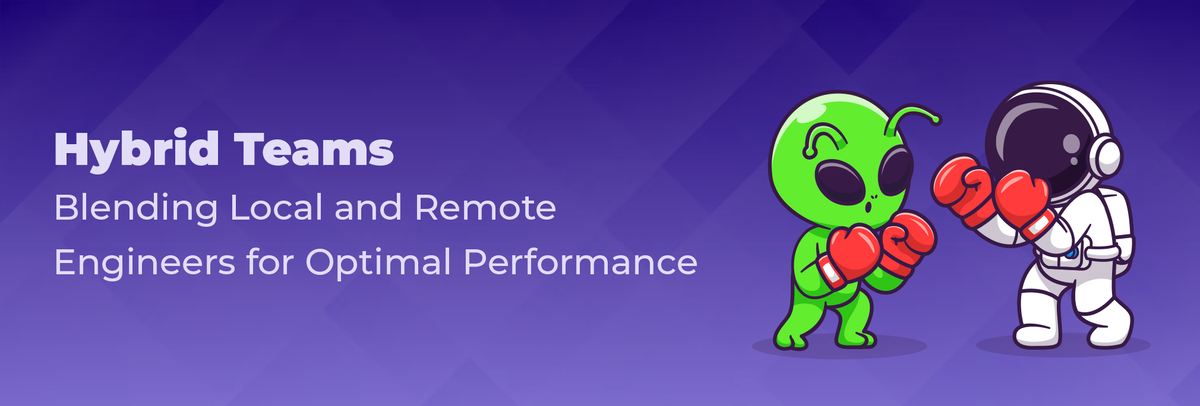Hybrid Teams: Blending Local and Remote Engineers for Optimal Performance

In the evolving landscape of modern work environments, the concept of hybrid teams emerges as a pivotal strategy, poised to redefine organizational dynamics.
As businesses navigate the shifting tides of workplace paradigms, the fusion of local and remote talent becomes not just a trend but a strategic imperative for optimal performance.
By 2025, projections indicate that an overwhelming 82% of businesses will have adopted a hybrid work model, signifying its enduring relevance and impending standardization.
This marks a substantial progression from 2020 when 65% of global workplaces had already embraced hybridity.
Today, a staggering eight out of ten employees find themselves either hybrid or fully remote, and this trend shows no signs of abating.
In fact, statistics suggest that approximately 30% of hybrid workers may consider departing from companies that fail to offer blended teams and flexible remote work policies, underlining the profound impact of this paradigm shift on talent retention and satisfaction.
In this dynamic landscape, understanding the nuances of blended teams isn't merely advantageous—it's essential for fostering innovation, productivity, and employee well-being.
Join us as we delve into the intricacies of hybrid teams, exploring how organizations can leverage this blend to unlock unprecedented levels of success in the digital age.
What Are Hybrid Teams?
Hybrid teams are teams within an organization composed of both remote and in-person members.
These teams leverage a combination of physical and virtual collaboration to achieve their goals.
In a hybrid team also known as a mixed team, some members may work from a central office, while others work remotely, either from home or satellite offices.
The key characteristic of such teams is their ability to blend different work modalities seamlessly, allowing team members to collaborate effectively regardless of their physical location.
This setup offers the flexibility of remote work while still enabling face-to-face interactions and fostering a sense of belonging and team cohesion.
Mixed teams are becoming increasingly common as organizations embrace flexible work arrangements and leverage technology to facilitate remote collaboration.
Why Companies Choose Hybrid Work?
Beyond the recent buzz around hybrid work and the coronavirus-induced mode of operation, hybrid work offers significant benefits.
Many companies have realized the utility of hybrid work and have plans to offer this option to their employees fully.
According to a recent survey conducted by McKinsey, the majority of participants who have implemented the hybrid model over the past two years express intentions to maintain it indefinitely.
This is mainly because the advantages of hybrid work are numerous, both for employers and employees.
Benefits for Employees
Did you know that in hybrid setups, productivity has risen for 58% of employees?
Employees benefit from having the flexibility to maintain a healthy balance between their work and personal lives.
They can spend more quality time with their family members and possibly have the time to pursue hobbies.
For companies with offices located in megacities, employees can cut out commute time and put it to good use.
With these conditions in place, employees are likely to experience higher productivity. Burnouts are also reduced.
Advantages for Employers
Alternatively, maintaining a hybrid model offers significant benefits for a company's culture.
It demonstrates to employees that their well-being is a priority for employers, signaling a deliberate effort to promote flexibility.
Hybrid work can lead to cost savings for employers by reducing operational expenses.
Due to hybrid work, there has been a 30% decrease in the need for office space, indicating shifts in how workspace is utilized and managed for cost efficiency.
Strategies for Effectively Leading a Blended Team of Engineers
Did you know that 63% of high-growth companies utilize hybrid work models?
Here are some strategies for effectively leading combination teams.
- Hiring Strategically
When transitioning to a hybrid model for your engineering team, selecting the right talent is paramount.
It's crucial to recruit individuals with strong collaboration abilities, capable of effectively collaborating with colleagues across locations.
Moreover, your engineering team members should demonstrate autonomy in their work, minimizing the need for constant oversight.
Managing a hybrid team can be challenging, and it's essential to avoid micromanagement by hiring self-directed individuals.
Additionally, prioritize traits such as adaptability, responsiveness, and punctuality in your hiring process.
While previous experience in hybrid or remote work is advantageous, it's not always a prerequisite, especially when candidates possess the requisite technical proficiencies.
- Establishing Transparent Expectations and Equitable Performance Metrics
When overseeing your hybrid engineering team, it's crucial to clearly outline expectations for each team member.
Define individual roles to provide clarity on tasks and align everyone toward common objectives, reducing potential conflicts.
Additionally, consider adapting performance metrics to suit the hybrid work environment.
Traditional metrics like working hours may not effectively assess performance in this setting.
Instead, implement a results-oriented approach, evaluating team members based on their ability to deliver results and contribute effectively, irrespective of their work location.
This approach ensures fairness and bridges the gap between on-site and remote workers, offering a more equitable evaluation method for team members with diverse working arrangements.
- Foster Clear Communication
Encouraging clear communication is paramount in leading a blended team of engineers.
- Emphasize the importance of regular updates, status reports, and project discussions to keep everyone informed and aligned.
- Utilize a variety of communication tools and platforms to facilitate collaboration and information sharing among remote and in-office team members.
- Encourage active listening and provide opportunities for team members to ask questions and seek clarification as needed.
By fostering a culture of open communication, you can ensure that all team members feel valued and engaged, regardless of their physical location.
- Implement Cross-Training Initiatives for Remote and Traditional Teams
To enhance the skillset and collaboration within a blended team of engineers, consider implementing cross-training initiatives that bridge the gap between remote and traditional work environments.
Encourage knowledge sharing and skill development among team members through cross-functional training sessions and workshops.
By equipping remote and local teams with a diverse set of skills and expertise, you can enhance their ability to collaborate effectively and adapt to changing project requirements.
- Implement Agile Work Practices for Distributed Teams
Embrace agile work practices to effectively manage distributed teams of engineers.
Break down projects into smaller, manageable tasks and establish clear goals and deadlines for each team member.
Encourage frequent communication and feedback loops to promote transparency and accountability within the team.
Utilize project management tools and agile methodologies to track progress and adapt to changing priorities in real-time, ensuring that remote and local teams remain aligned and productive.
- Cultivate a Culture of Inclusivity and Flexibility
Promote inclusivity and flexibility within the blended team by acknowledging and respecting the unique needs and preferences of remote and on-site team members.
Encourage open communication and active participation from all team members, regardless of their physical location.
Provide opportunities for remote and local teams to collaborate on projects and share best practices, fostering a sense of unity and camaraderie.
Embrace flexible work arrangements and accommodate different working styles to ensure that all team members feel valued and supported in their roles.
About Teamo: Empowering Your Hybrid Team
In the rapidly evolving landscape of modern work environments, Teamo emerges as a catalyst for organizational success.
As businesses navigate the complexities of blending local and remote talent, Teamo offers a transformative solution designed to elevate team performance to unprecedented levels.
With Teamo, organizations gain access to a curated pool of top-tier software developers from emerging markets.
These pre-screened professionals are seamlessly integrated as remote powerhouses into your development team, ensuring a harmonious fusion of skills, expertise, and innovation.
Whether your team operates from the comfort of home offices, satellite locations, or traditional workplaces, Teamo provides the technological backbone necessary to foster collaboration, communication, and productivity.
Leveraging cutting-edge tools and platforms, Teamo empowers your hybrid team to transcend geographical barriers and achieve collective success.
Embrace the future of work with confidence and embark on a journey of fearless growth with Teamo by your side.
Together, we'll unlock the full potential of your business and propel it to new heights in the digital age.
FAQs
- What is hybrid work technology?
Hybrid work technology encompasses a range of tools designed to facilitate and optimize work environments that blend remote and in-office settings.
These tools, both digital and physical, aim to support collaboration, communication, and task execution regardless of employees' locations.
- What are some common tools used in hybrid work environments?
Common tools used in hybrid work environments include:
- Workplace planning tools: These tools offer insights into space utilization, helping organizations optimize their physical work environments.
- Collaboration tools: These platforms facilitate teamwork by providing channels for sharing ideas, tracking project progress, and managing files.
- Communication channels: Platforms such as video conferencing software enable real-time communication among remote teams.
- Request management tools: These tools streamline the process of managing project-related requests and queries from employees, clients, and contractors.
- Physical tools: Hardware and supplies tailored to support remote work, such as laptops, monitors, and ergonomic furniture.
- Data and reporting tools: These tools collect and analyze data related to office utilization, productivity metrics, and other key performance indicators essential for managing hybrid work environments.
- How does artificial intelligence contribute to hybrid work technology?
Artificial intelligence (AI) plays a crucial role in enhancing hybrid work technology, particularly in areas such as human resources (HR).
AI-powered solutions can automate repetitive tasks, streamline administrative processes, and provide valuable insights into workforce dynamics, productivity trends, and employee sentiment.
By leveraging AI in HR, organizations can optimize their hybrid work strategies, improve employee experiences, and make data-driven decisions to support organizational goals.




